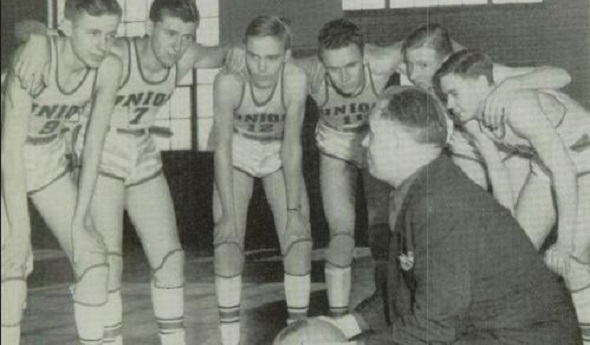
The Last Time MHSAA Finals were Canceled
By
Ron Pesch
MHSAA historian
April 27, 2020
Historians trace the start of World War II to German dictator Adolph Hitler’s decision to invade Poland on September 1, 1939. The Empire of Japan’s involvement in the war became effective in September 1940 with the signing of the Tripartite Pact.
Until December 7, 1941, the United States avoided official involvement, declaring themselves “a neutral nation.” Then came Imperial Japan’s bombing of Pearl Harbor.
A labor shortage caused by World War I had taken out spring high school sports in Michigan in 1917. As noted in the Second Half article, “1918 Pandemic, WWI Threatened High School Sports,” the global spread of a devastating strain of influenza interrupted the football season in Michigan. Prep athletics would roar through the 1920s and survive the Great Depression before seeing another interruption.
That next disturbance had nothing to do with war’s insatiable desire for manpower. Rather, it was because of tires.
“When the Japanese bombed Pearl Harbor, rubber instantly became the most critical strategic material for making war,” wrote Stephen W. Sears in the October/November issue of American Heritage magazine in 1979. “Nine-tenths of the nation’s rubber came from the Far East, and it was painfully evident that nothing would now stop Japan from cutting off that source.”
Americans consumed nearly two-thirds of the world’s production of rubber. With only about a year’s worth of material on hand, “Just four days after Pearl Harbor a freeze was put on the sale of new passenger-car tires,” stated Sears, “and on December 27 tire rationing was authorized, to go into effect early in January, 1942. Sales of new cars also were halted.”
The MHSAA
The Michigan High School Athletic Association arrived in December 1924. It replaced the old Michigan Interscholastic Athletic Association which had served Michigan for 15 years.
The organization’s primary purpose was to standardize, interpret and administer rules, educate and guide officials, and regulate student eligibility within prep sports in Michigan. By the 1940s, it had evolved into an association that also managed postseason tournaments, designed to identify state champions in specific sports: swimming, cross country, golf, tennis, track, and the sport sponsored by the most high schools in the state, basketball.
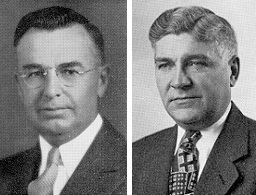 “The old MIAA had taken over the regulation of basketball tournaments in 1920. This had been done as a service to the schools and especially as a means of eliminating evils inherent in the invitational tournaments (that were hosted by various colleges around the state and the midwest),” wrote Lewis L. Forsythe in his book, Athletics in Michigan High Schools, recalling the first 100 years of prep sports in the state.
“The old MIAA had taken over the regulation of basketball tournaments in 1920. This had been done as a service to the schools and especially as a means of eliminating evils inherent in the invitational tournaments (that were hosted by various colleges around the state and the midwest),” wrote Lewis L. Forsythe in his book, Athletics in Michigan High Schools, recalling the first 100 years of prep sports in the state.
“In the last days of February 1942,” multiple Michigan schoolmen were in San Francisco to attend the annual meetings of Secondary School Principals, Superintendents and the National Federation of State High School Associations. “We were well aware that many of our boys in school would have to offer themselves in the service of their country,” noted Forsythe in his publication. “We fully realized that the quality of that service and, indeed, their own survival might well depend quite as much on their physical fitness as on their intellectual and spiritual resources. It was under those circumstances that we determined so to modify the emphasis of our athletic program as to make the largest possible contribution to the war effort. We recognized that the need in Michigan could not be met by our organization alone, and we therefore determined to encourage a general enrollment of all school groups in a united effort for promotion of physical fitness.”
Because of the “scarcity of tires and automobiles,” in April 1942 the MHSAA announced plans to curtail their upcoming annual golf and tennis events, eliminating a state championship round. Instead, the seasons were concluded with separate eastern and western sectional tournaments, hosted in Ann Arbor and Grand Rapids.
Early in May of 1942, MHSAA executive director Charlie Forsythe, nephew of Louis Forsythe, announced that the Association was “working on plans designed to make body-building exercises available to more young men and to spread recognition of sports achievements. He predicted substantial growth of intramural sports to include youngsters whose limited prowess might keep them from such interscholastic sports as football, baseball or basketball.”
Wire articles had told the story of how the running Battle of the Atlantic had impacted U.S. ocean transportation along the eastern seaboard. A Germany-mounted “campaign against American coastal shipping” by U-boats (submarines) was devastating “a section of America almost exclusively dependent upon ocean-point tankers for its petroleum products.” Without a viable alternative means to transport the products, on May 15, 1942, gasoline rationing began in 17 seaside states and the District of Columbia. It was hinted that gas rationing – specifically designed to save rubber – could roll out nationally. (Crude oil is the main ingredient in man-made rubber.)
The chances for restrictions in Michigan were a distinct possibility. According to P.J. Hoffmaster, the state’s supervisor of wells, the state consumed approximately 140,000 barrels of oil per day, but produced only 64,054 barrels. “This state has a shortage of at least 100,000 barrels on the basis of a regional demand,” he said, noting Michigan oil also supported needs outside the state. “When people say there can’t be rationing in Michigan because we have plenty of our own oil, they don’t have the true picture.”
Reverberations begin
When quizzed on the subject before the annual Lower Peninsula Track and Field championships, hosted at Michigan State College in May 1942, (Charlie) Forsythe, told The Associated Press he was unsure how rationing might affect the Association’s annual playoffs.
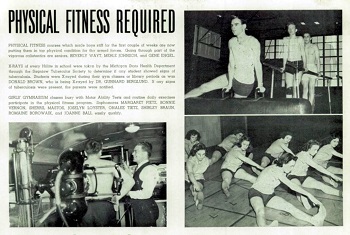 “It is too early as yet to say exactly. … We are making every effort to maintain an adequate athletic program. Certainly where common carriers (busses and trains) will make it possible to get a team to a game, that means should be used,” Forsythe said. He added that the Association was “surprised to find the number of schools competing in this year’s tournaments practically equaled last year’s entries.”
“It is too early as yet to say exactly. … We are making every effort to maintain an adequate athletic program. Certainly where common carriers (busses and trains) will make it possible to get a team to a game, that means should be used,” Forsythe said. He added that the Association was “surprised to find the number of schools competing in this year’s tournaments practically equaled last year’s entries.”
A total of 162 schools had qualified individual contestants in the track championships, about 10 percent fewer than in 1941. However, L.L. Frimodig – the assistant director of college athletics at M.S.C. and acting director of the state track meet – felt “the actual field in the four-class carnival would be much smaller than the number eligible to compete,” considering the circumstances of travel. “Many coaches,” he said, “would think in terms of tires rather than trophies before embarking on any sizable journey to the meet.”
The threat of rationing was almost immediately seen within Michigan’s resorts and travel industry.
“July and August have been moved up into June,” wrote the Detroit Free Press. “This is the word that comes from various parts of the state. Evidently, determination to get the vacation over before gas rationing may be decreed is one of the factors that has stepped up the season. … Reports of heavy patronage at nearby resorts over Memorial Day week-end can be taken as an indication of the trend, or necessity in 1942 of holidays enjoyed close to home base.”
Come September, Joseph B. Eastman, national director of the office of war transportation, called for help in reducing consumption of natural resources: “We intend to solicit the help of colleges and universities in making arrangements for transfer of scheduled games to centers of population where as many people as possible will have an opportunity to attend football games without traveling.”
At the college level, the freshman eligibility rule was waived due to the loss of manpower tied to military enlistment and the enactment of the Selective Training and Service Act of 1940. Its passage required all men between ages 21 and 45 to register for the first peacetime draft in U.S. history. With entry into the war, in December 1941, it was amended to require all 18 to 64-year-olds to register, with starting age for likely draft lowered to 20.
“The seasons of 1942-45 turned the (college) game upside down, creating new juggernauts and decimating some old ones,” wrote Sports Illustrated in its 1971 article, “When Football Went to War.”
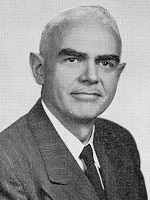 “Michigan’s 85 high school athletic leagues are speculating on the effects of the office of defense transportation plan to whittle sports travel drastically,” stated an Associated Press (AP) article soon after Eastman’s announcement. The Southwestern Conference, comprised of Kalamazoo Central, Benton Harbor, Muskegon, Holland, Grand Haven and Muskegon Heights and one of the most widely spread major prep circuits in the state, was told by its regular bus company that its busses were not available for charter.
“Michigan’s 85 high school athletic leagues are speculating on the effects of the office of defense transportation plan to whittle sports travel drastically,” stated an Associated Press (AP) article soon after Eastman’s announcement. The Southwestern Conference, comprised of Kalamazoo Central, Benton Harbor, Muskegon, Holland, Grand Haven and Muskegon Heights and one of the most widely spread major prep circuits in the state, was told by its regular bus company that its busses were not available for charter.
On Sept. 25, according to AP, “the state department of public instruction warned today that a threat of ‘no new tires’ will be held over rural schools which use their school busses to transport football players to and from games.”
Julian W. Smith, named the interim director of the MHSAA when Charlie Forsythe went into military service, didn’t think the directive would have much impact on football schedules. “However, I believe the order will have a serious effect on basketball schedules this winter and on next year’s football schedule.”
“Four Gallons a Week for Most Drivers”
Two days later it was announced that nationwide gas rationing would go into effect at the beginning of December 1942. More immediately, compulsory tire inspections every 60 days and a “Victory Speed Limit” of 35 miles per hour, effective Oct. 1, were also enacted. “This is not a gasoline rationing program, but a rubber conservation program,” said William M. Jeffers, president of the Union Pacific Railroad, which had been placed in charge of the government’s struggle to alleviate the rubber shortage.
“The object is not to take cars off the road, but to keep them on the road. … The safe life of a tire at 50 miles per hour is only half as great as it is at 30 m.p.h.”
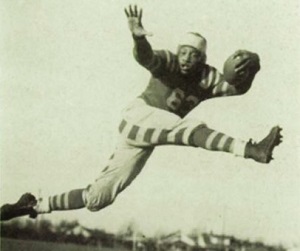 After initial announcements of game cancellations, the impact on high school football in Michigan in 1942 appears to have been minimal. Solutions were found to most challenges. In Bessemer, the high school superintendent announced that “enough persons have volunteered their automobiles to take the Speed Boy players to Calumet” for the game, scheduled for Saturday, Oct. 3. At season’s end, Flint Northern, Detroit Catholic Central, Muskegon, and Wyandotte each lay claim to a share of Michigan’s mythical football title.
After initial announcements of game cancellations, the impact on high school football in Michigan in 1942 appears to have been minimal. Solutions were found to most challenges. In Bessemer, the high school superintendent announced that “enough persons have volunteered their automobiles to take the Speed Boy players to Calumet” for the game, scheduled for Saturday, Oct. 3. At season’s end, Flint Northern, Detroit Catholic Central, Muskegon, and Wyandotte each lay claim to a share of Michigan’s mythical football title.
But a hint of what was to follow came with an announcement concerning the annual Cross Country Finals. The state meet was cancelled to reduce travel, with honors instead awarded during October meets to which schools were assigned based on geography.
In its October 1942 bulletin, the MHSAA endorsed a commando-type “training plan drafted by the Minnesota branch of the office of civilian defense” to “step up scholastic physical fitness programs.” When plotted on a football field, the course bordered the playing area with 11 obstacles spaced 20 yards apart. The course required participants to jump a 4-foot fence, crawl under a 2-foot-high rope, then run between a maze of stakes and, later in the course, high-step through a series of open boxes. Students would scale a 7½-foot wall, walk on a 12-foot balance beam, swing across a broad jump pit from a rope that hung from above, then climb another rope hung from the crossbar of the goal posts. Once accomplished, the participant was to move, hand-over-hand, across the span of the crossbar before dropping to the ground.
At the end of October, the MHSAA’s Representative Council acknowledged the direct contribution that interscholastic sports had on the “lives of students and citizens of the communities in which they are offered” while recommending that they be “retained insofar as possible.”
The committee, however, also emphasized its belief “that physical fitness programs for all students, and intramural sports to offer opportunity for competition to all, should be stressed in the schools’ athletics program.
“In all probability,” it continued, “it will be necessary to modify the general plans of conducting tournaments.” The mechanics of modification would be hammered out at the next Council meeting to be held in December in Lansing.
Financial concerns also were expressed, as much of the Association’s operating budget came from a share of gate receipts of tournaments.
The Impact
“All over the state, athletic directors and coaches are tackling transportation problems. Instead of piling the athletes into privately owned automobiles or school busses, coaches have diligently studied timetables of regular train and bus lines with many satisfactory results,” stated the AP on Dec. 4.
That same day, the MHSAA announced that the upcoming basketball postseason would be altered due to rationing. The story was picked up by various newspapers across the Midwest.
“The association’s Representative Council last night stressed need for following a ‘principle of minimum travel’ in basketball play this winter and voted to dispense with the annual Lower Peninsula finals,” instead opting for a modified layout. Initial conversation related to a plan calling for sectional meets with the possibility of naming titles in the northern half of the Lower Peninsula, and in both the southern and eastern areas. An appointed basketball committee was also to consider combining enrollment classifications wherever necessary to localize tournament play.
From 1932-1947, inclusive, separate Lower and Upper Peninsula basketball champions were determined. The Upper Peninsula Athletic Committee announced a similar plan at its meeting in January of 1943. The committee expected to present winners of the U.P. events with certificates instead of the customary trophies due to shortage of materials prompted by the war.
According to a survey of its 40 member state associations by the National Federation of State High School Associations, Michigan was one of only four states, including Maine, Montana and Nevada, to eliminate naming basketball state champions come the winter of 1943, “since the distances within those states are too vast or transportation facilities are too limited. The same will prevail in track contests.”
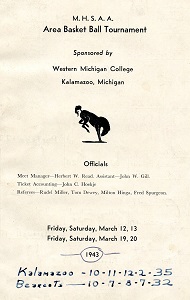 By mid-January, the MHSAA had polled its membership, and approximately 95 percent of the state’s high schools indicated a desire to participate in the replacement tournaments pitched by the Association. After examining the logistics, the plan previously discussed was modified. The Association then identified 51 Lower and 11 Upper Peninsula sites, based on availability to host the tournament and geographic suitability. The competition would run for two weeks, and end with what had previously equaled District championship contests.
By mid-January, the MHSAA had polled its membership, and approximately 95 percent of the state’s high schools indicated a desire to participate in the replacement tournaments pitched by the Association. After examining the logistics, the plan previously discussed was modified. The Association then identified 51 Lower and 11 Upper Peninsula sites, based on availability to host the tournament and geographic suitability. The competition would run for two weeks, and end with what had previously equaled District championship contests.
In the meantime, the annual swim championships were reduced to a one-day meet. Hosted at the University of Michigan, the meet would tax the endurance of individual swimmers, “since officials … decided to conduct semi-final events additional to the customary qualifying trials and finals.” That meant a swimmer entered in two events could compete six times during the day, with qualifying events in the morning, semifinals in the afternoon and finals swum at night. Perennial powers Battle Creek Central and Ann Arbor University High emerged as champions.
“The war to date has proved one thing conclusively – athletics in all schools must go on, for they serve to properly condition our young men for the bigger task ahead,” said MHSAA interim director Smith, speaking at an “annual football and basketball ‘bust’ for Lakeview High School” in Battle Creek in February 1943. Smith had served as principal at the high school for 14 years before taking over at the MHSAA. He “expressed regret” that the MHSAA had altered the various formats of the annual championships. According to coverage of the gathering in the Battle Creek Enquirer, “he intimated that it, along with all other forms of statewide competition, would be restored before another school year begins.”
Continued Chaos
The cities of Lansing and Kalamazoo played host to the most contingents, with 25 teams across the four enrollment classifications playing games at recently completed Lansing Sexton – the rechristened Lansing Central High School – and the Lansing Boys Vocational School. A total of 23 schools squared off at Western Michigan College of Education (now Western Michigan University).
As previously stated, transportation considerations meant some schools played above or below their normal classification to make things work. Ecorse, normally a Class B school, battled in the Class A tournament hosted at Dearborn Fordson. Benton Harbor, with Class A enrollment numbers, competed in the Class B tournament played across the St. Joseph River at St. Joseph High School instead of at the Kalamazoo Area tournament against similarly-sized schools.
A total of 128 area titles were awarded across the state’s two peninsulas. Decatur, the Class C state champion in 1942 with a 25-0 record, was the only team titlist to repeat in 1943, emerging with one of the “Area” crowns and extending its streak of victories to 41 consecutive. Also among the winners was Grand Rapids Union, a “cellar team in the regular season.”
“Although Union stood seventh in the city tally, the Red Hawks won the Area Tournament Crown in three smashing, spine-tingling battles,” stated the sports editor in the 1943 Aurora - Union’s yearbook. “In fast games the Hawks overcame Catholic and beat the Creston Bears … as well as whipping Davis Tech for their final victory.”
In April, the MHSAA confirmed that competition would end with area, city or conference meets in track, and again in tennis and golf, because of transportation, participation issues, and the “prospects of closing of some of the schools early.”
Various fans and media members grumbled about the unsatisfying conclusion to the prep sports calendars.
Hope
The coaching ranks were heavily hit by the war, as numerous mentors were tapped by the armed forces to lead physical fitness programs. Despite initial concerns, few “of the state’s 400 football-playing prep schools” dropped the sport come the 1943-44 school year. As it would turn out, because of the travel constraints, attendance increased as more and more sports fans turned to high school competition for entertainment.
Smith stated in October that he had “yet to find anyone who is definitely against bringing the (basketball) championship tournament back to life. There seems to be overwhelming sentiment in favor of the revival. The schools right-about face on the state cage classic which annually drew 700 prep teams and 11,000 players is explained by the fact coaches now feel the federal government is strongly in favor of any attempt to encourage or extend athletics. Last year schoolmen were not certain what the government’s attitude on sports would be and were hesitant about continuing athletics in pre-war style.”
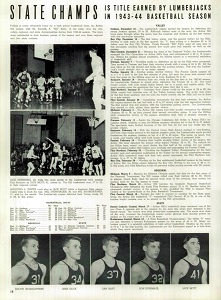 Only 258 of 614 schools replied to a questionnaire about restoring the winter basketball state championships, but 73 percent of respondents were in favor of such, and in December, the Representative Council voted to resume the final rounds of the tournaments.
Only 258 of 614 schools replied to a questionnaire about restoring the winter basketball state championships, but 73 percent of respondents were in favor of such, and in December, the Representative Council voted to resume the final rounds of the tournaments.
Born October 1918 in St. Johns, Michigan at the peak of the “Spanish Flu” pandemic, Hal Schram was a 25-year-old sports reporter for the Lansing State Journal when he covered the restart.
“State championship basketball and track competition once more became a part of (the) Michigan high school athletic program when the Representative Council of the MHSAA voted to reinstate these two state-wide tournaments after a suspension of one year,” he wrote.
According to Schram, “It was believed that student working hours, transportation, scarcity of balls and general lack of interest” still necessitated cancellation of golf and tennis tournaments for the year. Conduction of a swimming championship was left “in the hands of a committee representing schools which sponsor the sport … subject to the approval of the representative committee.”
Plans were to return the final rounds of the basketball tournament to Jenison Field House on the campus of Michigan State, which had hosted those rounds from 1940-42. However, the facility was in use by Army trainees for a physical fitness program.
“We would like to have the finals staged here very much,” said MSC athletic director Ralph Young, “but our obligations to the army come first.”
“Despite the hitch, the executive committee opted to stay in Lansing, playing Class A and C semifinal contests at the Boys Vocational School fieldhouse, and Class B and D semi games at Sexton High School. Finals were held at the Vocational gym.
“Fifty-five hundred spectators jammed their way into every nook and cranny of the Boys Vocational school fieldhouse last night to see four high school teams (Saginaw Arthur Hill, Marshall, Lansing St. Mary, Benton Harbor St. John) win championships in the Lower Peninsula tournament finals. With all seats taken almost before the first game started, the big floor was completely encircled by people sitting and standing before the finish,” wrote State Journal sports editor George S. Alderton. “By 6 o’clock, when the Class D game started, all seats in the side bleachers had been filled and most of the end bleachers were gone. The last vacancy was occupied before the Class C game started at 7:15 o’clock and from that time on, those who came either stood or seized a seat left by some departing fan. In many instances two sat down when one departed. Corners of the court were seething masses of humanity …”
United Press International wire reports indicated that 8,500 in total saw the Finals, as fans shifted in and out of the venue in support of the participating teams. “Some people had to be turned away at the finals,” said Smith, “and that certainly shows that people need and want this kind of relaxation.” The previous three Finals at MSC had drawn between 6,000-7,000 fans, while the 1939 Finals at I.M.A in Flint drew 5,000 and the 1938 event at Grand Rapids Civic Auditorium saw 6,000 attend.
“Lighting was so poor in the press box Friday night for the semi-finals,” added Alderton, “that workers came equipped with candles for the finals on Saturday night and propped them against their typewriters.”
Ishpeming hosted the Upper Peninsula Finals, as Escanaba, Crystal Falls, Channing and Amasa swept titles, respectively, in Classes B, C, D and Class E – the state’s smallest classification, reserved only for the smallest U.P. schools based on enrollment.
“Only complaint,” noted the Marquette Mining Journal, “was from those who couldn’t get in or were caught in a jam of fans seeking general admission seats. … Probably another 100 to 200 could have been accommodated if they were permitted to sit on the floor all along the court lines, but this would have been hazardous to players and fans …”
 (The Lower Peninsula finals returned to Jenison in 1945 – where they stayed, uninterrupted, through 1970 – and were played before 7,833 spectators that first season back. Locals were delighted as they watched Lansing Sexton top Benton Harbor’s undefeated Tigers, 31-30. Michigan Governor Harry Kelly “personally presented the Class B championship trophy to Sturgis Capt. Tom Tobar, congratulated Capt. Larry Thomson of East Lansing and then shook hands with the captains of the Class A contest before the game started.”)
(The Lower Peninsula finals returned to Jenison in 1945 – where they stayed, uninterrupted, through 1970 – and were played before 7,833 spectators that first season back. Locals were delighted as they watched Lansing Sexton top Benton Harbor’s undefeated Tigers, 31-30. Michigan Governor Harry Kelly “personally presented the Class B championship trophy to Sturgis Capt. Tom Tobar, congratulated Capt. Larry Thomson of East Lansing and then shook hands with the captains of the Class A contest before the game started.”)
In mid-May, “some 800 Michigan prep trackmen, survivors of 40 regionals at 10 centers” headed to Michigan State College to determine statewide champs. Only Kalamazoo in Class A and Birmingham in Class B held the chance to “repeat” as team champions. Instead, Saginaw Arthur Hill capped a stellar sports year, earning its first Class A team track title to go with its recently-earned basketball crown. (Earlier in the school year, the Lumberjacks also had opened their own football field.)
East Grand Rapids earned its second track title, grabbing the Class B crown. Fowlerville and Glen Arbor Leelanau brought home titles in Class C and D, respectively.
All sports – including golf and tennis which had gone three years without competing in a true state title round – returned to their original formats with the start of the 1944-45 school year.
In May 1945, Germany surrendered to the Allies, followed by Imperial Japan’s surrender, announced in August.
Participation in prep sports and attendance numbers would explode across the state and the nation in the coming years, tied to multiple factors, including, of course, the baby boom that followed World War II.
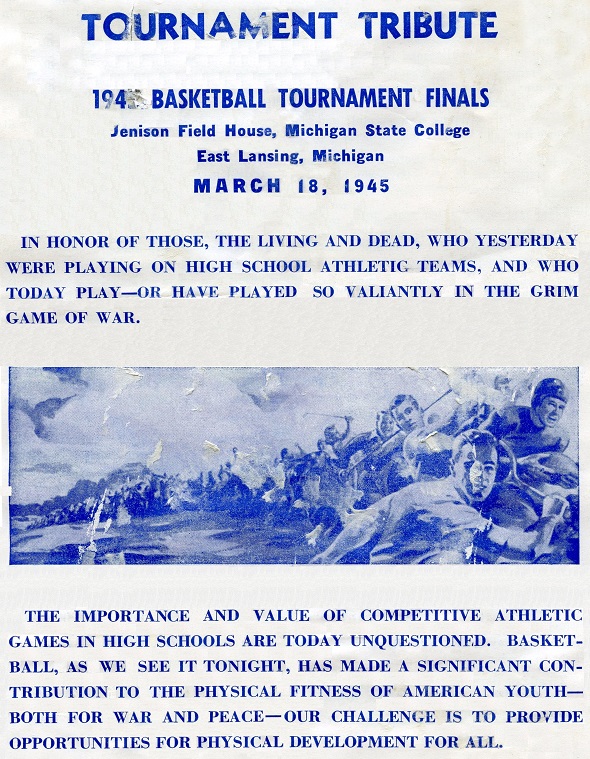
 Ron Pesch has taken an active role in researching the history of MHSAA events since 1985 and began writing for MHSAA Finals programs in 1986, adding additional features and "flashbacks" in 1992. He inherited the title of MHSAA historian from the late Dick Kishpaugh following the 1993-94 school year, and resides in Muskegon. Contact him at [email protected] with ideas for historical articles.
Ron Pesch has taken an active role in researching the history of MHSAA events since 1985 and began writing for MHSAA Finals programs in 1986, adding additional features and "flashbacks" in 1992. He inherited the title of MHSAA historian from the late Dick Kishpaugh following the 1993-94 school year, and resides in Muskegon. Contact him at [email protected] with ideas for historical articles.
PHOTOS: (Top) Grand Rapids Union was among "Area" boys basketball champions in 1943. (2) Lewis Forsythe, left, and Charles Forsythe were among leaders during the MHSAA's first decades (3) The Saginaw Arthur Hill yearbook for 1944 tells of fitness training undertaken by students. (4) Julian W. Smith served as interim MHSAA executive director while Charles Forsythe was serving in the military. (5) Flint Northern's Bill Hamilton earned all-state honors in 1942. (6) Western Michigan College was among hosts of 1943 Area tournaments. (7) Arthur Hill's yearbook celebrates the 1943-44 boys basketball championship. (8) Basketball Finals returned to Jenison Field House in 1945. (9) The MHSAA paid tribute to World War II veterans in its 1945 Basketball Finals program.
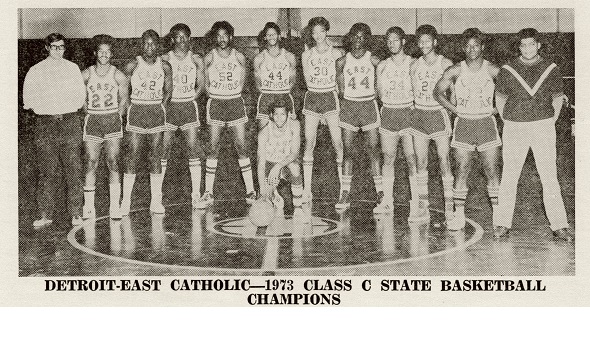
As Soules Guided, East Catholic Reigned
January 31, 2019
By Ron Pesch
Special for Second Half
“I’m surprised to be this far. Some nights we play very good and some nights we play very bad. I just didn’t think we’d be consistent enough to get this far.”
The words were spoken by varsity basketball coach Dave Soules of Detroit East Catholic back in 1973, but, no doubt, could have come from any number of coaches who have found themselves, unexpectedly, somewhere deep into the MHSAA postseason.
It was Soules’ first season in charge of Detroit East Catholic’s varsity, but far from his first year in the building the school occupied.
The Chargers had advanced to the Class B Quarterfinals the previous year, falling to perennial powerhouse River Rouge, 65-64. That East Catholic team was coached by Eugene Dennis Alexander. An all-city player at Detroit Northeastern, Denny Alexander played college ball at Aquinas in Grand Rapids and became only the fourth player in Michigan collegiate history to surpass 2,000 points in a career, joining John Bradley of Lawrence Tech, Dave DeBusschere of the University of Detroit and the University of Michigan’s Cazzie Russell on the list. In May of 1969, at age 23, he was named head coach at East Catholic.
 Denny’s brother, Darryl Alexander, was East Catholic’s best ballplayer in 1972. The team streaked to 11 straight victories during the regular season, then squared off in a series of late February games against larger Detroit Public School League teams. The scheduling was designed to ready the squad for the postseason. Losses to Detroit Southeastern (68-47), Detroit Kettering (80-71) and Detroit Northern (59-58) were a means to that end. While the Chargers did not make the Detroit Catholic League tournament, they were ready to do some damage in the Class B MHSAA tournament.
Denny’s brother, Darryl Alexander, was East Catholic’s best ballplayer in 1972. The team streaked to 11 straight victories during the regular season, then squared off in a series of late February games against larger Detroit Public School League teams. The scheduling was designed to ready the squad for the postseason. Losses to Detroit Southeastern (68-47), Detroit Kettering (80-71) and Detroit Northern (59-58) were a means to that end. While the Chargers did not make the Detroit Catholic League tournament, they were ready to do some damage in the Class B MHSAA tournament.
Only a field goal by River Rouge’s Byron Wilson with 26 seconds remaining prevented the Chargers from doing more. East Catholic trailed in the Quarterfinal by as many as 14 points, and made valiant runs to pull within a point on two occasions, but couldn’t upset coach Lofton Greene’s Panthers. Alexander finished with 19 to again lead the Chargers but was lost to fouls with 1:37 remaining in the third period. Trailing 61-53, East Catholic cut it to 61-60 with 1:35 left to play on a Phil Young field goal. Larry Merchant’s pair of free throws again brought the margin to a single point, 65-64 – but with only five seconds left, the Chargers were out of miracles.
River Rouge, on the other hand, was not. The Panthers would advance through the Semifinals and then survive another thriller, escaping with another one-point victory in the title game against Muskegon Heights. That win marked their 12th Class B title in 19 years.
The Chargers finished the season with a 16-7 record. Alexander earned Associated Press Class B all-state honors that season as a senior, averaging 20 points, 13 rebounds and six assists per game. Come the fall, the brothers headed north to Central Michigan University, where Darryl became a prized recruit. In mid-September, CMU president William Boyd announced Denny had been hired as an assistant coach.
In 1977, Denny was interviewed for the head coaching vacancy at Wayne State, and then was named head coach at Xavier University in New Orleans in 1978.
In 1966, with shrinking enrollments driven by flight of parishioners to the suburbs and rapidly changing neighborhood demographics, the Roman Catholic Archdiocese of Detroit directed that four Catholic high schools on Detroit’s east side – St. Catherine, St. Rose, Annunciation, and St. Charles – consolidate into the old St. Catherine building at 4130 Maxwell Street.
The amalgamation was christened Detroit East Catholic, and it opened its doors in the fall of 1967.
But the mergers were simply not enough. Needs for new equipment, combined with increased costs for teacher salaries and legislative changes to funding meant a need to increase tuition to cover expenses. That, in turn, led to even more departures.
 “The East Side Catholic schools ran up a total deficit of over $1 million last year,” said Bishop Thomas J. Gumbleton, vicar general of the archdiocese, announcing additional closings and mergers of high schools and elementary schools planned with the conclusion of the 1968-69 school year.
“The East Side Catholic schools ran up a total deficit of over $1 million last year,” said Bishop Thomas J. Gumbleton, vicar general of the archdiocese, announcing additional closings and mergers of high schools and elementary schools planned with the conclusion of the 1968-69 school year.
Detroit St. Anthony and Detroit Elizabeth were merged into East Catholic to help address the deficit and exodus. With the changes in the fall of 1969, East Catholic High School was relocated from St. Catherine’s to the St. Anthony building a mile away at the corner of Field and Frederick streets.
Soules had graduated from Dearborn Sacred Heart in 1957 and then the University of Detroit. He was hired as an English teacher at St. Anthony and became the school’s JV basketball coach in 1962. In 1964, he took charge of the varsity team.
“When we merged (into East Catholic) they divvied up the jobs and Dennis got the basketball job,” said Soules in 2005 to Mick McCabe, Detroit Free Press sportswriter. “If I’d have got the job, I’d have lost my mind. I mean literally. The merger was painful. Everybody hated everybody else …”
In May 1972, the Free Press had interviewed Soules about the challenges and the future of the school located at 5206 Field. As an assistant principal, he spoke for those who remained.
“From here, there isn’t any place to go. You close up, and you go out of business. If we keep working at it and keep believing in it, it’s gonna keep going. It has so far. If we close, there’s no inner city Catholic school on the lower east side,” he said.
Raffles, paper drives, lollipop and baked good sales, car washes, fish dinners and dances all contributed to keeping the doors open.
Making a new school community from all of the former had not come easily.
“It was hell. I lost 25 pounds last year. We lost a lot of good staff people. But we came back this year, and, all of a sudden, people could smile at each other in the halls. That’s important. As people got to know each other, they did become friends,” Soules added
With Alexander’s late departure, Soules became the school’s newest varsity basketball coach. At the time, no one knew that he would also be the school’s last.
With the graduation of Darryl Alexander, the expectations of the team, loaded with juniors and sophomores, were limited. Smaller enrollment meant the team had fallen a classification come tournament time. With a 5-3 mark, the Chargers were No. 5 in Hal Schram’s weekly Free Press Class C Top Ten in early January, but had fallen well out of the United Press International’s Top 20 Class C rankings by mid-February with a 12-4 record. The team was quickly eliminated in the annual Detroit Catholic League tournament and, unranked in the final state polls, carried a 12-6 record into the MHSAA postseason. Following District wins over Hamtramck St. Florian – ranked eighth by AP – and Hamtramck St. Ladislaus, Soule’s crew quickly changed the landscape in the opening round of the Class C Regionals.
 “Just two days into regional play, the tourney is starting to live up to its Pseudonym – ‘March Madness’”, wrote Harry Atkins for The Associated Press.
“Just two days into regional play, the tourney is starting to live up to its Pseudonym – ‘March Madness’”, wrote Harry Atkins for The Associated Press.
“The Chargers were given hardly a chance against a talent-rich Dearborn St. Alphonsus team in Class C action,” continued Atkins, “but East Catholic didn’t let Dearborn’s No. 2 ranking scare them as they matched the Arrows basket for basket.” Trailing by six with 1:46 left to play, Larry Merchant’s field goal with 46 seconds left tied the score. “Then Mike Walton hit a free throw with one second on the clock to give East Catholic its upset.”
Mike Woods led the team with 21 points. St. Alphonsus exited the tournament with a 22-2 mark.
On a very snowy evening across Michigan, East Catholic took advantage of its height and survived a 27-point performance by New Haven’s Don Sims to win their Regional and advance to the Quarterfinals of the MHSAA tournament. Merchant scored 10 of the Chargers’ 11 points in the final four minutes to seal the 68-63 win.
Merchant showed off his ball-handling skills dishing out 12 assists in the 71-48 Quarterfinal win over Erie-Mason. Sophomores Greg Guye, a 6-foot-6 center, and Walton, a 6-2 sophomore guard, each pumped in seven field goals, both finishing with 14 points, to lead the Chargers in scoring.
Merchant scored 26, while Walton added 23 – 18 points over his season average – as East Catholic rolled to a 66-55 Semifinal victory over Battle Creek St. Philip to earn a trip to the championship game.
“We had accurate scouting reports on East Catholic,” said St. Philip coach Tom Miller following the game. “They were quick. I knew we were in trouble when we had a fast break – and they had two guys at the other end waiting for us,” Miller told UPI’s Richard Shook, laughing. “At least we got beat by a team that was better than we were.”
The state’s scribes had a week to contemplate the upcoming Final matchups as Michigan’s tournament format of the time injected seven days between the Semifinal and Final rounds. Soules had never won a tournament game as a coach at St. Anthony, and noted his club’s strengths and challenges to the media during the time.
“This is a young team which makes mistakes,” he told Atkins of the AP, “but we don’t quit and we’ve won some games on hustle in the last few minutes. It is difficult to key on one player and beat us, because we have excellent balance.”
In a conversation with Schram he noted that his team had a tendency to work out big leads, then start to get sloppy.
“We’ve never put anyone away yet,” he added. Schram noted that Soules took only half of the 700 tickets allotted East Catholic at the state association. “I won’t sell all that I have. These kids simply don’t have the bread to go running all over the state.”
“I don’t believe many of our students or fans have a great amount of confidence in us,” declared the coach, but emphasized that was not the view of the team. “They want this state title and will fight all the way to win it Saturday.”
By most, if not all accounts, not many others had faith in the Chargers’ chances in the championship matchup.
“St. Stephen lost in the ‘C’ finals in 1972 to Shelby and have their key players returning,” wrote Fred Stabley Jr. in the Lansing State Journal. “Led by 6-5 Elijah Coates and 6-2 Jimmy Beavers, St. Stephen has the size and speed to win it all this year.”
“Every game is a home game for Saginaw St. Stephens,” noted Atkins in his pregame AP write-up. “The Titans have a frenzied following of nearly 1,500 fans at every tournament game and you can bet your last lottery ticket they’ll all be in Ann Arbor for Saturday’s showdown.
 “On paper there’s no way you can pick a favorite … but neither St. Stephens nor East Catholic has been winning on paper … Saginaw, however, has done a slightly better job of it and who can measure how much their loyal throng of well-wishers has contributed to that record.”
“On paper there’s no way you can pick a favorite … but neither St. Stephens nor East Catholic has been winning on paper … Saginaw, however, has done a slightly better job of it and who can measure how much their loyal throng of well-wishers has contributed to that record.”
“East Catholic won’t make the trip to Ann Arbor for nothing,” wrote Schram, as his alter ego, “The Swami,” on the Saturday of the game. “There’s a trophy for the runnerup.”
Saginaw coach Sam Franz, celebrating his 25th year as a coach, may have been the only skeptic.
“Any team that comes this far has to have something more than luck going for them,” said Franz to Schram.
The story of the Final can still be seen in silence today.
“From the late 1940’s to the mid 1970’s the Michigan High School Athletic Association shot portions of the action at its basketball finals on 16mm film,” notes John Johnson, communications director for the MHSAA. “Some of the films only have portions of the second half and the postgame awards; some have most of the action. None of the films have sound.”
One of the surviving films is the 1973 Class C classic. The Chargers blew a 10-point lead late in the third quarter. With 2:29 remaining, the game was tied, 46-46. A free throw gave St. Stephen the lead 47-46 with 2:16 to play.
The final two minutes of film spools out the story, in thrilling – and heartbreaking – detail.
In the days before the possession arrow, jumps for possession could mean the difference between victory and defeat. East Catholic won a possession on a jump ball, but a miss by the Chargers and a defensive rebound by St. Stephen sent the Titans into stall mode. However, a turnover grabbed and converted by Merchant gave the Chargers a 48-47 lead with just over a minute to play.
A pair of free throws by Elijah Coates pushed St. Stephen out front 49-48 with 45 seconds left. Yet with four seconds remaining on the clock, Merchant's 18-foot jumper from left of the key gave the Chargers a 50-49 victory.
The front page of the Free Press shouted the headline, “A Chance to Be Somebody,” with a story representative of the time. Focused on the players and their struggles, the title could have easily applied to the re-start of a coaching career, and a life, which ultimately would become legendary at least on Detroit’s east side.
 To students, he became famous for a rope of keys around his neck, his pad of detention slips and the substitution of “Hot Dog” or “Baby” for names when trying to keep the halls clear during the school week. Saturday mornings for many included time in “The Jug” serving detention.
To students, he became famous for a rope of keys around his neck, his pad of detention slips and the substitution of “Hot Dog” or “Baby” for names when trying to keep the halls clear during the school week. Saturday mornings for many included time in “The Jug” serving detention.
“He’s more to East Catholic than just the basketball coach,” Lou Miramonti told Jo-Ann Barnas of the Free Press in 1996. Miramonti, the athletic director at Royal Oak Shrine, knew of whom he spoke. “It’s the most visible thing he does, but it may well be the least important thing that he does at that school and for those kids.”
Soules was assistant principal, disciplinarian, tuition collector, the giver of rides, and one who called students just to make sure homework was getting done. And, of course, the coach that guided the talent that came through the halls of a building that today no longer stands.
Playing witness in 2005 to another sweeping closure of schools by the Detroit archdiocese – one that included the shuttering of East Catholic – Soules discussed a career he never could have predicted.
“I was the right guy who just happened to be in the right place at the right time,” he explained to McCabe as he tried to come to grips with the announced closing. Soules’ coaching career at East Catholic featured 544 wins against 250 defeats over 33 seasons. The Chargers’ athletic cases included eight MHSAA Finals championship trophies won by his teams. To this day, only Greene at River Rouge won more.
An honest, humble and caring individual with a “self-deprecating sense of humor,” he discussed those earliest of days:
“The saddest part is, I was so dumb at the time, we didn’t win it again (over the next two years) … I didn’t know how to deal with the 2-2-1 three-quarter court press (in 1974) … in the semis (in 1975) … we just weren’t ready to play.”
“With some of the kids I had, you didn’t have to be a genius,” he stated. “I’m a lot better coach now than I was then.”
In 2009, Soules passed away after a three-year battle with cancer. His extended family numbered thousands.
The many condolences that followed, and that continue today, are a heartfelt testament to the difference one man can make in a life, both on the court and in the hallways, of an ancient building built with the lofty purpose of education.
 Ron Pesch has taken an active role in researching the history of MHSAA events since 1985 and began writing for MHSAA Finals programs in 1986, adding additional features and "flashbacks" in 1992. He inherited the title of MHSAA historian from the late Dick Kishpaugh following the 1993-94 school year, and resides in Muskegon. Contact him at [email protected] with ideas for historical articles.
Ron Pesch has taken an active role in researching the history of MHSAA events since 1985 and began writing for MHSAA Finals programs in 1986, adding additional features and "flashbacks" in 1992. He inherited the title of MHSAA historian from the late Dick Kishpaugh following the 1993-94 school year, and resides in Muskegon. Contact him at [email protected] with ideas for historical articles.

PHOTOS: (Top) The Detroit East Catholic 1973 Class C championship team. (2) Denny Alexander was hired as East Catholic boys basketball coach in 1969. (3) The former Detroit St. Anthony High School. (4) Dave Soules coaches his East Catholic players during the 1973 season. (5) Film survives from the Chargers’ 1973 championship game win over Saginaw St. Stephen. (6) Soules instructs his team during a 1996 game. (7) The Detroit East Catholic gymnasium, after the school’s closure. (Photos gathered by Ron Pesch.)

